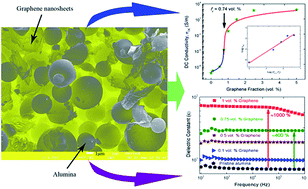High performance alumina based graphene nanocomposites with novel electrical and dielectric properties†
Abstract
In a simple and effective strategy, different vol% of thermally reduced graphene nanosheets were uniformly dispersed in alumina and then consolidated by spark plasma sintering. The composite demonstrates a substantial tenfold improvement in the dielectric constant almost independent of frequency with reasonably low dielectric loss only at 1 vol% of graphene. In contrast, similar improvements have been observed through complex hybrid nanostructures in a polymer composite at 20 or even higher vol% of graphene. It is proposed that the highly resistive oxygenated functional groups residing on the surface of thermally reduced graphene nanosheets act as an interface layer or intrinsic barrier to restrict the leakage current thus resulting in low dielectric loss of the composites. The electronic transport behavior of 3D interconnected nanosheet architecture in alumina shows a striking resemblance to a carbon nanotube network of varying thickness. The temperature dependent conductivity transforms from tunneling conduction to variable range hopping as the graphene vol% decreases from 5 to 1.5 vol% below 40 K and exhibits a makeover from metallic to less metallic behavior. The composite possesses high room temperature electrical conductivity ≈803.27 S m−1 at 5 vol% of graphene that surpasses almost all ceramic composites prepared by the simple blending/mixing method.


 Please wait while we load your content...
Please wait while we load your content...